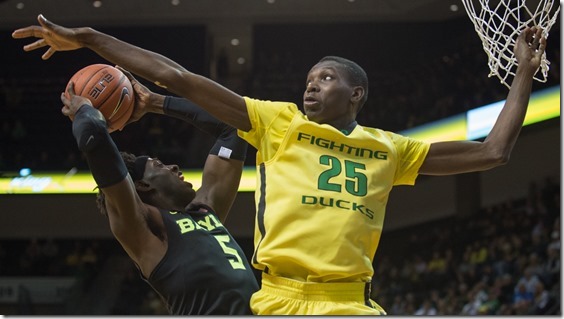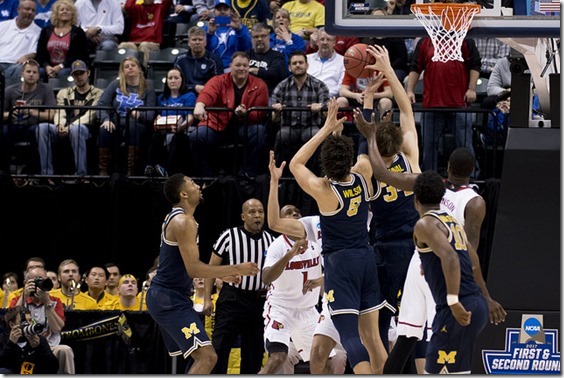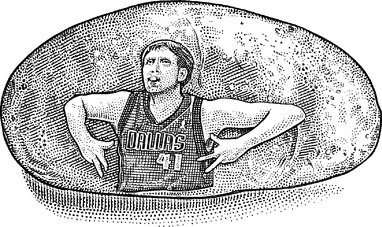oregon
Boucher tore his ACL in the Pac-12 tournament
The absent man. Oregon post Chris Boucher is a major, major loss for the Ducks. Boucher played 20 minutes a game with excellent shooting (63/35) on high-ish usage; he has a top-ten block rate nationally; he is an excellent rebounder. In the three games since he went out, Oregon's given up
- 1.19 PPP against Arizona, the #17 Kenpom offense,
- 1.10 PPP against Iona, the #69 Kenpom offense, and
- 1.13 PPP against Rhode Island, the #59 Kenpom offense.
That looks like a major step back for a team with an adjusted D efficiency of 0.95 PPP.
In the aftermath, smallball. Oregon was already an up-and-down team playing one big, and now they are more so. 6'9" Jordan Bell is a terrific athlete who replicates most of what Boucher brings to the table except three-point shooting. With Boucher out, 6'11" Kavell Bigby-Williams is getting about 15 minutes a game as Bell's backup. Those are all the players taller than 6'7" with more than spot playing time.
This is kind of what they were doing before and now they're all-in on it. If that sounds like a recipe for more transition, you are correct. A quarter of Oregon shots come in the first ten seconds of the shot clock, which is a near-Oklahoma-State level of pushing the ball. Meanwhile their eFG% is a deadly 64%—exactly the same as Michigan. Their points are split about evenly between rim runs and three-pointers.
Stop me if you've heard this before: stopping transition is Michigan's #1 job in this game. Oregon goes from lethal from behind the arc (44%) to meh (36%) if you can just get them into the latter two thirds of the shot clock. Their eFG% plunges 11 points to 53%.
For what it's worth, Michigan could not prevent Oklahoma State from getting up a ton of transition looks—22 of their 64 shots—but held them to 48% eFG. Oklahoma State was vastly more effective in the halfcourt, ironically.
[Marc-Gregor Campredon]
Shot parity watch. Michigan can expect to win most games during which they take the same number of shots as their opponent does, and Oregon is no exception. Michigan's got a good chance to do so—better than they had in the first two games. Even with Boucher Oregon struggled to rebound in Pac-12 play, finishing 9th on the defensive boards and 7th on offense. Over the course of the season they finished 64th nationally on the offensive glass, which is good but a far cry from the two teams Michigan just beat.
It remains to be seen how much Michigan can take advantage of Oregon's middling-to-poor defensive rebounding. On the one hand, Iona(!) rebounded almost 40% of their misses and Rhode Island got 31% of theirs. On the other, Michigan will not be inclined to send extra guys to the boards given Oregon's deadly transition game. If Michigan can draw help defense they'll have an excellent shot to grab an offensive board since anyone rotating down is going to be either a bit shorter or a ton shorter than Wilson and Wagner.
Turnovers should be advantage Michigan. Oregon is good but not great at both ends. Michigan is Oregon's equal at forcing turnovers and is once again elite at preventing them.
DJ meets (hopefully) future DJ, on one end of the floor. Jordan Bell is a putback and roll-man on offense, almost exclusively. On the other end of the floor he is the same kind of versatile defender DJ Wilson is, except better. DX's scouting report on him dubs him an "enforcer," and that's about right:
If Oregon decides to switch everything it is in Michigan's best interest to go after Not Jordan Bell, who's the rare 6'9" guy who can significantly contest a Walton stepback three. Also, if Bell gets switched onto the perimeter Oregon's rim protection evaporates.
With Boucher out Bell has hamblasted the offensive boards. He had 7 against Iona and 6 against Rhode Island as Oregon rebounded about half their misses in both games. After watching Louisville bigs anticipate shots much better than Michigan's counterparts just a few days ago, it seems inevitable that Bell will get 6-10 points on putbacks. C'est la vie.
Bell's offensive game remains rudimentary. As of a month ago, when that DX video went up, he had attempted just 10 two-point jumpers all season. DX's summary of his post game consisted of a couple of tough fadeaways hit over larger personnel. This isn't a bad defensive matchup for Wagner, but Wilson has been occasionally rough when he tries to defend P&R from the five spot, and Bell is not a guy who's easy to recover on if you find yourself out of position.
DJ meets kinda-DJ on the other. Oregon 4 Dylan Brooks is a 6'7" dude with a smooth three-point stroke and the straight line drives that result from guys biting on pull-up three fakes.
That video shows a lot of Brooks exploiting traditional posts or guards who get matched up on him; he's a good player but one who seems like he might be susceptible to the things Wilson is good at right now. Wilson's length gives him the ability to bother pull-up threes without opening up lanes to the basket.
Brooks is also the kind of guy who Zak Irvin has been giving fits for about half the season. (See: Edwards, Vincent and Bridges, Miles.) Brooks will get his; if he does so by taking 20 shots to get 15 points Michigan is in good shape.
Guards! Guards! Sam Vimes veritably infests the roster. The rest of Oregon's rotation ranges from 6'2" to 6'4". Wilson no doubt remembers PG Dylan Ennis:
Wilson went to the bench with an injury after that game and ended up taking a redshirt. Since then circumstances have changed radically for both players. For one, you'll note that Ennis is playing for Villanova in that clip.
At Oregon he's nondescript statistically, with decent outside shooting (37%) propping up an otherwise meh profile. He gets to the rim a lot, where he's bad—52%—but there's a bunch of Jordan Bell Kobe assist potential lurking in those shots.
Tyler Dorsey is Oregon's second best scorer behind Brooks, a 41% three point shooter on excellent volume, who's reasonably effective at the rim. Payton Prichard and Casey Benson, the only reserve, are basically the same player: low usage Just A Shooters who occasionally decide to attack closeouts with middling-at-best results. Both guys assist at a reasonable rate but have TO rates uncomfortably high for gentlemen of their persuasion. Neither is particularly effective inside the arc.
Oregon is a catch and shoot team. Nobody has an appreciable number of unassisted threes other than Dillon, who's hit 15. The rest of the roster collectively has 25—8 fewer than Derrick Walton. This should mean that closeout-mad Michigan can restrict their deep attempts. When Oregon runs pick and roll they are not looking to rise up from any range (only Brooks is 40%+ on two point Js) so Michigan can hedge soft and recover.
Difficult to resist force versus not very moveable object. When Oregon is on offense this is a matchup between the team that takes the fewest two-point jumpers amongst major conference schools and the team that forces the second most*. 19% of Oregon's shots are two point jumpers, because everyone except Brooks is very bad at them. 45% of Michigan's ceded shots are two point jumpers.
Any time an Oregon guy gets run off the three point line and has to pull up that's a win.
*[Baylor passed Michigan this week. /shakes fist.]
This is not me. I wish it was.
Whoever sent me this POTATO!!!! Much appreciated.... pic.twitter.com/fVaqRvvgTn
— Dirk Nowitzki (@swish41) March 15, 2017
It turns out to be a wildly successful marketing stunt for a company that will send you image or message-emblazoned potatoes. This company is inexplicably not based in Ohio. The best thing to come out of this is the Wall Street Journal giving the headshot treatment to Dirk's tuber:
Twitter did not find this nearly as amazing as I did, but rest assured this is incredibly entertaining.
Oregon: good matchup? The WaPo's Neil Greenberg seems to think so. He's using extremely small sample sizes, but given Chris Boucher's absence that's less unfortunate than it usually is. Transition is a major Oregon focus and Michigan's stepped up their stinginess:
In transition, Michigan has allowed opponents to score 39.1 percent of the time in the tournament, an improvement over their regular-season performance (46.3 percent) and a potential stumbling block for Oregon, who has scored almost two-thirds of the time in transition (63.6 percent) against their first two opponents. No other remaining tournament team has had better results on the break. Take that element away from Oregon, and it’s a big blow.
This item won't surprise you but will shock your January self:
The Ducks also won’t get as many open looks as they have through the first two rounds. Oregon has taken 24 of 32 (75 percent) catch-and-shoot opportunities unguarded, per Synergy Sports, scoring 1.08 points per shot. Michigan, however, has allowed just six of 22 (27 percent) catch-and-shoot attempts without a defender close by.
Oregon is was already a bit three-heavy with Boucher in the lineup and figure to be more so without him even if that hasn't shown up in the three games since his departure, and Michigan is very good at preventing threes from being launched.
They're 5'9" with big hair and one of them doesn't have a work visa. Welp, they've been found. Both DJ Wilson and Mo Wagner are major risers on Chad Ford's NBA draft board:
Moritz Wagner, F/C, So., Michigan
No one did more to help his draft stock over the weekend than Wagner. His career-best performance against Louisville -- 26 points on 11-for-14 shooting -- showed why he was been quickly moving up our Top 100 over the past month. Wagner is a fluid athlete at 6-foot-11 who can score off the bounce and on the block. He also has 3-point range.
When he's engaged and not in foul trouble, he can take over a game. The fact that he did it against a bunch of NBA-caliber athletes on Louisville impressed scouts. He sat at No. 40 on our Top 100 before the tournament and moves up to No. 21 in our latest rankings. That's a huge leap for any player, but if you watched his draft stock all month, it isn't just based on one game. It's just scouts getting more and more comfortable with the idea that he has all the skills he needs to be a good NBA player someday.
D.J. Wilson, F, Jr., Michigan
Wilson showed off all the strengths of his game against both Oklahoma State and Louisville. He's a terrific and versatile athlete who can stretch the floor, finish at the rim and block shots. He can even handle the ball and bring it up the floor.
However, his lack of toughness continues to bother some scouts who want to see him initiate and handle contact better. He grabbed only two boards against Louisville and at times seemed bothered by the physicality. Still, athletic 6-foot-10 guys who can shoot 3s and protect the rim don't come along every day and Wilson has made a strong case to be a first-round pick after hovering in the 30s in our Top 100 all season.
FWIW, I was talking to Sam Webb a month or two ago and at the time his impression was that the NBA was interested in both guys but that they were both likely a year away. Let's hope that's still the case, because I'm guessing Teske and Davis are going to need another year of grooming before they're ready. Also I really want to see weaponized versions of Wilson and Wagner.
If one or both does end up going this will be another situation where Beilein's astounding player development—despite almost no access to one-and-done types Michigan was 12th in NBA players produced entering the season—outpaces his recruiting. Nobody was expecting Trey Burke or Nik Stauskas to be two-and-out, and I don't think anyone thought Wilson or Wagner would have any chance of going to the league this year after the pair averaged two points a game in 2015-16.
Remember when Bernard Robinson sticking at the end of a roster for a year or two was notable to Michigan basketball fans? Slightly different situation these days.
Part of that development. Congrats to friend-of-blog Andrew Kahn for landing a WSJ byline. It's a look into some player development tools Michigan (and others) are using. Wagner has a bad day against Ohio State and Beilein set to work on his shot:
...Beilein set out to fix Wagner’s problems using one of basketball’s hottest new diagnostic tools: a machine that measures the arc of a shot as it reaches the hoop. ... [tool vendor] Noah’s data says the ideal shot comes in at about 45 degrees.
Wagner’s practice session showed that he was shooting the ball far too high, coming in at around 53 degrees. Beilein knew they had no chance of going in and pressed Wagner to adjust by flattening his shot.
“By the time we were done, he was draining threes all over the place at 45 (degrees), 46, 47,” Beilein said. Wagner, a 41 percent three-point shooter for the season, shook his slump and nailed 8 of 17 (47%) from deep the next four games.
Beilein is still adapting and taking advantage of new tools being created even though he's "no spring chicken," which not every coaching in his 60s does. You can safely assume that Michigan is on the cutting edge with this stuff. The results are proof enough.
Two points. The Big Ten did pretty well in the first weekend of the tournament, sending three teams to the Sweet 16 and Shutting Up All The Haters, except not really. Mark Titus:
As soon as the buzzer sounded on no. 7 seed Michigan’s 73–69 victory over no. 2 seed Louisville on Sunday afternoon, the talk of the internet became whether the Big Ten, which was complete trash from November through early March, had been underrated all season. ... [The Big Ten got three S16 teams and the ACC was bad.] ... Clearly this had to mean something, right?
Of course not. You know what Michigan beating Louisville and Wisconsin beating Villanova proved? That Michigan outplayed Louisville and that Wisconsin outplayed Villanova. How come everyone who gets so wrapped up in conference-pride bullshit always seems to move the goalposts with these arguments?
Neither side of any conference superiority argument generally marshals anything resembling a coherent argument. It is talk-radio fodder.
While a few tournament games don't establish that the Big Ten was at the level it was a few years ago, neither was it "trash." They entered the NCAA tourney fifth out of six power conferences on Kenpom, all of two points behind the second-place ACC. That's roughly the difference between #20 Michigan and #24 Butler, or #37 Northwestern and #44 Illinois State—ie, barely any difference at all. The first two rounds should at least be sufficient to demonstrate that the Big Ten is in the same range as any other power conference (with the possible exception of the Big 12).
This weekend did matter in the computer rankings, sliding the Big Ten up to fourth, and it should influence our perception of the league this year. The real answer, though, is that the Big Ten was just slightly down. Titus seems to be projecting his feelings about Ohio State, which was so trash that many Michigan fans gave up on their season after losing to the Buckeyes*, to the wider league.
*[guilty]
Nice. 2017 PF Isaiah Livers won Mr. Basketball. He's a 6'8" stretch four with game and hair fairly reminiscent of DJ Wilson.
Wilson has a couple of inches of both height and hair on Livers, but hopefully he's able to step into the rotation next year.
Star-crossed Ricky Doyle. Remember how he was ill or injured seemingly perpetually? This has not abated, at all.
Ricky Doyle, a Bishop Verot Catholic High School alum, was forced to sit out this season after transferring from the University of Michigan due to NCAA rules, as well as a tumor.
“I just kept having these stomach pains for a long time and I just kind of pushed them off,” he said. “One day, I just had to go to the hospital and it turns out that my appendix has been burst for two months…they found a tumor about the size of a softball and they had to cut 6 inches of my colon out.”
The tumor was non cancerous, Doyle said, and his body formed it naturally around the burst appendix to prevent poison from seeping out and killing him.
Doctors believe the medicine Doyle is on for his sleep apnea dulled the pain to the point where he didn’t realize how severe the tumor was.
Poor kid.
Writing on the wall. There's a ton of football stuff that we'll get to in a week or two as part of a spring preview, but one roster note: Sam Webb replies to people asking about a lack of Shelton Johnson coverage that "he is not a part of [Scout's] defensive line preview." I would not expect him on the roster this spring.
Etc.: A lot of people say the tournament saps the importance of the college season. I don't buy that, because I like Big Ten championship banners. For an example of a season that truly doesn't matter, I give you the NBA.
Every Michigan 3 against Oklahoma State. Holdin' The Rope on the Louisville game. Five key plays from said game. We are #3 in Will Leitch's rootability rankings, because of "cattywampus." Leitch on the Brad Underwood hire. TTB talks to Kevin Koger. Jim Harbaugh promotes colon awareness.
How Michigan acquired Wagner. Salaries for newly hired staffers. Nigel Hayes vs the NCAA.
Via WD, every snap of Jake Rudock vs. Michigan. It is quite unimpressive, though I remind you it was debilitatingly cold and windy for the 2013 Crimes Against Manpanda Redux game, and he was a sophomore. There were three long plays in there. The first Kevonte Martin-Manley was WIIIIIDE open and Rudock's pass floated in (against the wind) slowly and inaccurately so KMM had to step immediately out of bounds. The second his receiver made a great play while double covered. The third was the one Avery and C.Gordon botched extraordinarily. The last throw on there was his best.
UPDATE: There's also an every pass vs Wisconsin.
To answer the guy in the thread, yes that is the game that inspired our most depressing shirt ever. My original shirt idea in the discussion that became that shirt was "Fuck it man, let's go bowling".
Transfers are Only Rare in Peace Time. As I partially experienced when they tried to tell me regular courses at La Sorbonne weren't French enough to count as foreign language*, transferring credits to Michigan is a bitch.
 |
| Transfer to Michigan for Victory! We're for winning the war too! |
For that reason more than its coaches' tastes (Rodriguez and Hoke both recruited plenty of JuCos before coming here), Michigan has taken extraordinarily few transfers over the years.
With five (Isaac, Lyons, O'Korn, Rudock, O'Neill) projected to be at Michigan this fall, Wolverine Devotee tracked down every transfer he could.
The short transfer list underscores the difficulty with admissions. In the last 30 years the only Michigan transfers not from like academic institutions (Stanford, USC, Georgia Tech, SDSU and Notre Dame), were freshmen from decent Ohio schools (Goodwin and Nienberg), one guy who was at Michigan previously (Evans), one guy from a local academic CC that sends a lot of students to Ann Arbor, and Russell Shaw, who is the lone exception to every conversation ever had about Michigan JCs and transfers.
It also has a bulge in the mid-1940s, when Michigan went all-in on active duty programs. Most notably the university created an intensive Japanese language school that took over East Quad, and was the wartime home of the national JAG program, which we housed in the Law Quad. Michigan gamely used these and the regular training school to siphon talent away from rivals in every sport. That's how we got Crazy Legs Hirsch out of Wisconsin, and Howard Yerges and J.T. White from Ohio State. Iowa Pre-Flight became a quasi-Big Ten team in the era by convincing stars from the region to enlist in the Air Corps.
Via the board there might be two more grad transfers en route before fall. Why is Michigan taking so many guys now (other than new coaches in non-Michigan places always bring in guys they recruited elsewhere to fill gaps?) Well one is grad transfers are a relatively recent phenomenon and are more like a normal admissions process for those schools.
For the rest, my best guess is during The Happening, Michigan had asked Harbaugh what ducks they need to be in what order, and one of his requests was admissions won't jerk him around. This happened at Stanford; in fact the school refusing to accept January enrollments cost him both RGIII and 2015 Heisman candidate Taysom Hill. This is just a wild theory, but "You could eff up our shot at Harbaugh" is probably one of the only football arguments you could ever make to admissions that they'd care about.
There is at least one transfer whom WD missed: 1997 co-captain Eric Mayes, who went to Xavier then transferred to Michigan and walked on, according to a certain co-worker of mine who's probably not ecstatic about me just pointing you to his old blogspot.
* (We acknowledge you read Voltaire in the original, but you weren't doing it to learn French!)
[Jump for Cazzie and a surprising stop in Brady Hoke's Offensive Vision Quest]



39